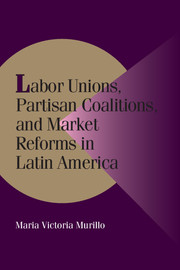Book contents
- Frontmatter
- Contents
- Abstract
- Acknowledgments
- List of Acronyms
- 1 UNIONS' DILEMMA: HOW TO SURVIVE NEOLIBERALISM
- 2 A THEORY OF UNION-GOVERNMENT INTERACTIONS
- 3 THE POPULIST PAST AND ITS INSTITUTIONAL LEGACIES
- 4 A TUG OF WAR: LABOR UNIONS AND MARKET REFORMS IN VENEZUELA
- 5 DIVIDED WE RULE: LABOR UNIONS AND MARKET REFORMS IN MEXICO
- 6 FROM PICKETS TO PRICES: LABOR UNIONS AND MARKET REFORMS IN ARGENTINA
- 7 MULTILEVEL COMPARISON
- 8 LABOR COMPETITION AND PARTISAN COALITIONS
- Bibliography
- Interviews
- Index
- Titles in the series
5 - DIVIDED WE RULE: LABOR UNIONS AND MARKET REFORMS IN MEXICO
Published online by Cambridge University Press: 05 February 2010
- Frontmatter
- Contents
- Abstract
- Acknowledgments
- List of Acronyms
- 1 UNIONS' DILEMMA: HOW TO SURVIVE NEOLIBERALISM
- 2 A THEORY OF UNION-GOVERNMENT INTERACTIONS
- 3 THE POPULIST PAST AND ITS INSTITUTIONAL LEGACIES
- 4 A TUG OF WAR: LABOR UNIONS AND MARKET REFORMS IN VENEZUELA
- 5 DIVIDED WE RULE: LABOR UNIONS AND MARKET REFORMS IN MEXICO
- 6 FROM PICKETS TO PRICES: LABOR UNIONS AND MARKET REFORMS IN ARGENTINA
- 7 MULTILEVEL COMPARISON
- 8 LABOR COMPETITION AND PARTISAN COALITIONS
- Bibliography
- Interviews
- Index
- Titles in the series
Summary
The conversion of the PRI from populism to neoliberalism was less dramatic than in Venezuela but it opened a new chapter in Mexico's political and economic history. The Mexican Revolution consolidated in a single-party system beginning in the 1930s. The governing party employed state expansion as a tool for economic development and political stability based on the distribution of subsidies and repression. Although its monetary and fiscal policies varied, the PRI continuously expanded the size of the state and promoted import substitution industrialization. From 1940 to 1956, import substitution industrialization and massive public investment were paid for with inflationary financing leading to frequent devaluations of the currency. After 1956, Mexico followed a strategy of “stabilizing development,” which was based on state intervention, high public investment, import substitution industrialization, and conservative fiscal and monetary policies, including a fixed exchange rate. As a result, between 1956 and 1972, the Mexican GDP grew 6.7% annually, but the annual inflation rate was only 3.1% (Lustig 1992: 220, Aspe 1993). Mexico was the first developing country to borrow regularly from international financial markets in the 1960s. This debt further promoted state expansion. About three-quarters of Mexico's foreign borrowing was undertaken by a growing public sector, with most loans going to state-owned enterprises (Frieden 1991: 190). Although the Mexican government was forced to devalue the peso in 1976, the discovery of new oil reserves led to a natural resource–based export boom that further expanded foreign borrowing during a period characterized by high growth and high inflation (Lustig 1992: 226–31).
- Type
- Chapter
- Information
- Publisher: Cambridge University PressPrint publication year: 2001



